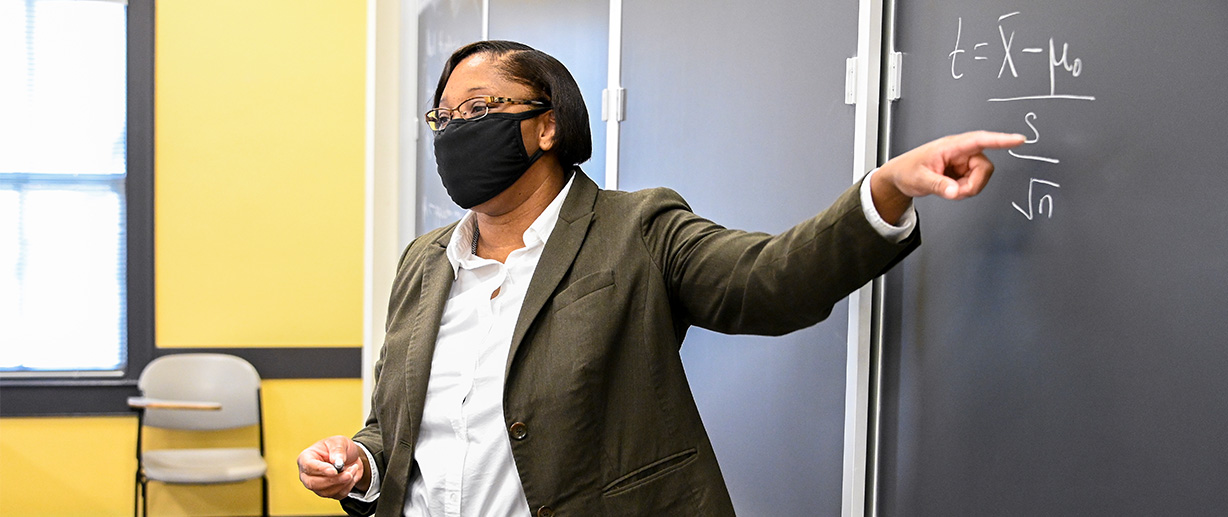The numbers don’t lie.
That’s especially true of Wofford College’s mathematics department, where women hold 50 percent of the tenure-track faculty positions and represent nearly 68 percent of math majors. Both figures are well ahead of national averages.
According to the American Mathematical Society’s Mathematical and Statistical Sciences Annual Survey, women held 37 percent of the tenure-track positions at undergraduate schools in 2018. About 42 percent of math majors were women in 2018.
The department has eight tenure-track positions. Dr. Rachel Grotheer became the department’s fourth woman when she came aboard this past fall.
Dr. Charlotte Knotts-Zides says it has been exciting to see the growth in the number of women in the department.
“I think there is a different perspective that women bring to the math field,” she says. “I definitely think our numbers are impressive. It is certainly a reflection of the women in the department as being capable of mathematics. I’m excited that our female students find themselves with these role models.”
Dr. Deidra Coleman, who is in her fourth year at Wofford, says a bias against women in STEM education is a by-product of age-old stereotypes. She says that as a Black woman she has felt discouraged at times as she pursued her career path.
“I get the layer of being a woman, and the layer of being a minority in a white-male dominated field,” she says.
Coleman says Wofford provides a more supportive atmosphere for women.
“For us, it’s exciting that we are encouraging students who might be underrepresented on a national level to stay in the program,” Coleman says. “A lot of times they are majoring in another program and we will convince them to add math.”
When Dr. Joseph Spivey, the chair of the department, arrived at Wofford in 2008, there were only two women – Knotts-Zides and Dr. Angela Shiflet, professor emeritus of computer science – in the department. And Shiflet split her time as chair of the computer science department.
Hiring women for the sake of parity was never Spivey’s goal. His objective was the same with each opening – to hire the best candidate from a broad, diverse pool of applicants.
“We know people are likely to be more successful in mathematics if they have a teacher who looks like them,” says Spivey. “Women, people of color and other under-represented groups are more likely to see themselves as mathematicians if they have a mentor who looks like them. And the more diverse faculty you have, the more attractive you are to people of all walks of life.”
Mathematics has not always been a welcoming field for women. There are some in the field, Spivey says, who still consider women to be inferior at math.
“Hundreds of years ago, women were not even allowed to be educated in mathematics,” Spivey says. “That sort of heritage stays with us today. There are a lot of under-represented people who are not mathematicians today because of that. We’re losing talent to other fields.”
Knotts-Zides says she was never discouraged from pursuing a career in mathematics. But she says she knew it was different.
“If there are 12 people in a class and only two or three are women, you knew that you were the unusual,” she says.
Caroline Sargent ’21 of Easley, South Carolina, is one of the 21 (of 31) current female math majors. She discovered her love for math while taking calculus to fulfill requirements for chemistry – her other major – and Spivey encouraged her to continue taking math classes. She says it helps to have female role models to talk to.
“They see the concerns that female students have,” Sargent says. “And I get to see how they’re balancing things outside of work, and it gives me hope when I see that.”
Emory Wyatt, a sophomore volleyball player from Greenville, South Carolina, was encouraged to major in math by former teammates Catie Cronister and Emily Durham. She said it’s inspiring to see so many women in the field at Wofford.
“It is so encouraging to be equally represented in this major,” Wyatt says. “It's refreshing to see women finally breaking some of the STEM barriers that have been in place for a long time. It made my choice much less intimidating knowing that I wouldn't feel out of place.”
